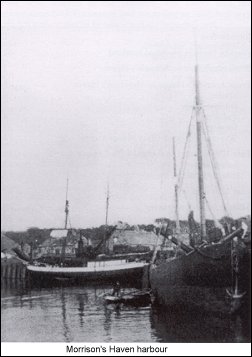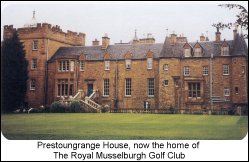The Baron of Prestoungrange
Dr. Gordon Prestoungrange
Interview by Sarah Powel (part 2 of 3)
Prestoungrange yesterday and today
There is a surprising amount of historical information on the
barony and on the mixed fortunes of Prestoungrange and its owners,
and the area's history is well recounted in a series of booklets
Gordon is publishing at www.prestoungrange.org. The name Prestoungrange
derives from "Prestoun", meaning Priests' town and "Grange" denoting
a farm. The earliest owners derived their wealth from the local
wool, farming and coal mining industries.
Robert de Quincy, the first recorded owner, was descended from
Norman knights. In the twelfth century he was an important member
of the court circle of the Scottish King William I (The Lion).
Gordon relates that "de Quincy subsequently granted Prestoungrange
to Cistercian monks from Newbattle Abbey and the Order remained
there for four hundred years. The monks introduced salt panning,
hence the town's early name of Saltpreston, now Prestonpans. In
the early 16th-century, they built a nearby harbour, Newhaven,
which was successively renamed Acheson's and then Morrison's Haven.
This was the first important step in the development of the area
as a significant, international manufacturing and trading station
on the Forth.
"The monks' main goal in building the early harbour was to facilitate
exports of coal, salt and hides and also to provide a safe haven
for local fishermen. Prestoungrange is reputed to have been Scotland's
first coal mining area.
"At the Reformation, the 'Commendator', or administrator of the
Cistercian estate at Prestoungrange, Mark Ker, took possession
of the properties which were subsequently granted by the King
as the Barony of Newbattle, which included the lands of Prestoungrange.
During Ker's tenure, a distinctively suggestive painted ceiling
was incorporated at the baronial home, Prestoungrange House, which
may, according to some contemporary theories, have been connected
to 16th-century practices of witchcraft. The ceiling was only
discovered - to some consternation - during renovation work in
1950 and has since been relocated to Merchiston Tower at Napier
University in Edinburgh.
"After the Ker family, who became the Earls of Lothian, several
other distinguished families held the lands and titles including
William Morison, Lord Prestoungrange, the Countess of Hyndford
and many generations of Grant Sutties. They all aided the development
of a range of secondary industries such as chemicals and soap,
glass, bricks and tiles, and pottery. The earliest sea-borne trade
from the port was with England, Holland and Sweden and this then
expanded to include the Baltic States, Germany, France, and Norway.
The harbour also brought in valuable additional revenue in the
form of dues.
"Robert Ker, the second Earl of Lothian, appears to have sold
the estates because of heavy debts. In 1624 he committed suicide,
beset by further debt - a not uncommon problem among the nobility
over the centuries. Prestoungrange House was then acquired by
the Morison family, in whose hands it remained for almost 150
years until debt - this time gambling was the cause - forced its
sale to William Grant in 1745 for the very substantial sum of
£Scottish 160,000.
"Prior to this William Morison had further developed the harbour,
renaming it as he did so. Trade was flourishing and, by the late
17th-century, as much as ten per cent of all Scotland's trade
with foreign ships passed through this port, and local fishermen
had moved on from their traditional catches to providing lobsters
and, particularly, oysters for Europe's nobility. Morrison's Haven
was also renowned for widespread smuggling and there were rumours
of secret passages to the beach from certain old houses in Prestonpans."
William Grant has been characterised as "an archetypal Scottish
Whig", a lawyer, supporter of the established Church, the
Union and the Hanoverian crown. He was also a Member of Parliament
from 1747 to 1754. By virtue of that office he played a significant
role in attending to matters in the aftermath of Bonnie Prince
Charlie's ill-fated attempt to reclaim the throne for the
Stuarts. Grant had the reputation locally for being rather
mean, although this might be unfair as he was known to be
supportive of the local development of industry and it was
he who established the manufacture of pottery. Exports of
Prestonpans "brownware" went to Europe, North America and
the West Indies.
On Grant's death his eldest daughter, the Countess of Hyndford,
inherited Prestoungrange, there being no sons. She took the
keenest interest in the farming activities undertaken there
and in her neighbouring baronies, especially Dolphinstoun
which is now held by Gordon's youngest son Julian. On her
death, it passed to her nephew Sir James Grant-Suttie and
his descendants. |
 |
Initially, this family's ownership was marked by increasing wealth
and expansion of the estate, reflecting the key importance of
coal to the Industrial Revolution. However, in the late 19th-century,
family circumstances led to the estate being managed by outside
advisors which, combined with a drop in revenue from coal, led
to a decline in the family's fortunes. While the baronial house
remained in the Grant-Suttie's ownership until 1956, for many
years from 1909 it stood empty. Ironically, the proximity of the
collieries, which had for so long contributed to its owners' prosperity,
had become a liability making it unattractive to potential lessees.
In 1924 the property was finally let to the Royal Musselburgh
Golf Club (RMGC) which was seeking to move from its existing site
next to the Musselburgh Race Course. Some thirty years later the
house was put up for sale but the RMGC was unable to raise sufficient
funds to purchase it. The Coal Industry and Social Welfare Organisation
came to the rescue, buying the house and grounds on behalf of
the Musselburgh Miners' Charitable Society and enabling the RMGC,
almost half of whose members were from the mining community, to
remain there as a golfing sub-section of the society - a mutually
beneficial partnership that continues to this day.
 |
The fortunes of the surrounding area have, however, continued
their decline. Gordon explains that "the harbour at Morrison's
Haven was badly silted up by the outbreak of the Second World
War, and was filled in with rubble and ash in the mid-1950s,
trade having been diverted to road and rail in the 1930s.
The coal mine closed in the early 1960s and the brickworks
ceased operation in the mid-1970s. Other traditional local
industries such as pottery and brewing have disappeared and
the local community has for too long now suffered the consequent
unemployment - such a transformation from its vibrant past." |
|





